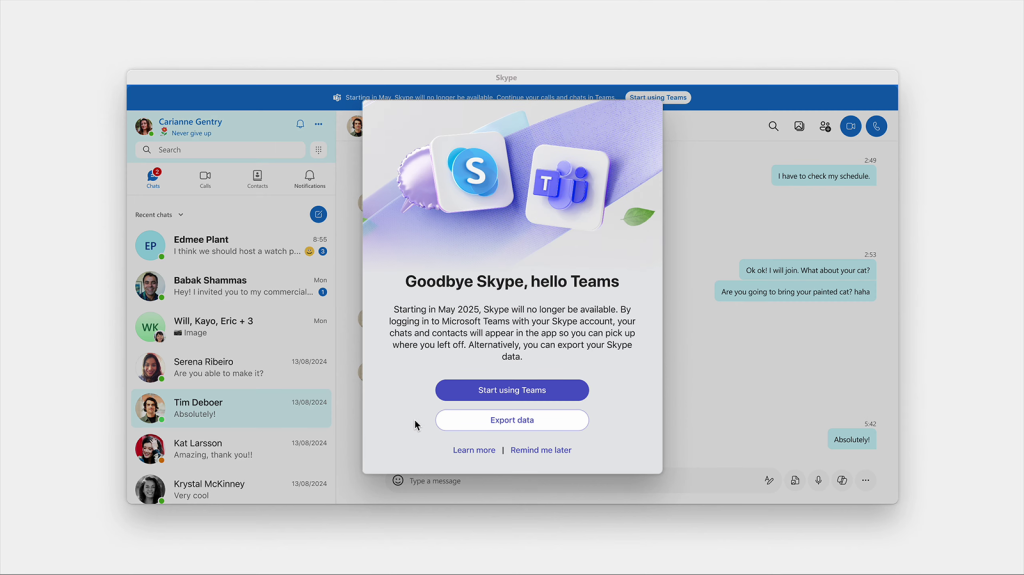
Microsoft Shuts Down Skype for Teams: The End of an Era. Microsoft is officially shutting down Skype this May, replacing it with the free version of Microsoft Teams. Existing Skype users will be able to sign in to Microsoft Teams and access their chat history, group conversations, and contacts automatically without creating a new account. Additionally, they will have the option to export their data. However, Microsoft will discontinue support for calling landline and international numbers.
Microsoft Ends Support for Skype for Teams
“Skype users will have control; they will have a choice,” says Jeff Teper, President of Collaborative Apps and Platforms at Microsoft 365, in an interview with The Verge. “They can migrate their chat history and contacts or transition to Teams if they prefer.”
If users choose to transfer their Skype data, the exported information will include chat history and photos. Microsoft has also developed a tool to view Skype chat history without migrating to Teams.
Key Dates & Transition Period
Skype will remain functional until May 5, 2025, giving users around 60 days to decide whether to switch to Microsoft Teams or export their data. “If they choose Teams, the initial setup process will be seamless since we’ve already done the necessary work to restore contacts, chat history, and call logs,” says Amit Fulay, VP of Product at Microsoft.
Migrating to Microsoft Teams will retain Skype’s group chats during the transition. Additionally, Microsoft will maintain interoperability, allowing messages sent from Teams to reach friends still using Skype.
Major Changes in Skype Features
While Microsoft Teams will take over most of Skype’s functionality, some features will be removed. Microsoft is discontinuing Skype’s telephony features, which previously allowed calls to landlines and mobile numbers. “We analyzed usage trends—this feature was great when VoIP wasn’t widely available, and mobile data plans were expensive,” Fulay explains. “Going forward, this is not an area we want to focus on.”
Microsoft will retain existing Skype credits but will no longer offer paid Skype features for new customers, such as making or receiving international and domestic calls. Users with active Skype subscriptions can use their credits and subscriptions in Microsoft Teams until their renewal period ends. However, Skype Number users must transfer their numbers to another provider, as Microsoft will no longer support this service.
The Skype dialer will temporarily remain in Teams for users with existing credits and subscriptions, but Microsoft will not offer consumer calling plans like it does for businesses. “The world has moved on,” says Teper. “The expansion of broadband and lower mobile data costs have shifted almost all communication to VoIP.”
Why Microsoft Is Shutting Down Skype
One of the key reasons behind Skype’s closure is the declining demand for traditional phone calls. Microsoft acquired Skype in 2011 for $8.5 billion, but over the past decade, services like FaceTime, Messenger, and WhatsApp have dominated the market with seamless messaging and video calling experiences.

Skype was first launched in 2003, and after Microsoft’s acquisition, it gradually phased out other communication products like Windows Live Messenger. In 2015, Microsoft attempted to integrate Skype into Windows 10, but this transition lasted only nine months. Microsoft initially launched separate apps for video calls, messaging, and voice calls before removing them in later updates.
This became particularly evident during the COVID-19 pandemic, when users flocked to Zoom instead of Skype. “Skype’s user base actually grew at the beginning of the pandemic and has remained relatively stable since then,” Teper admits. “It hasn’t seen a dramatic decline, but we want to ensure that users have control over their migration to Teams.”
The Future: Microsoft Teams as the Primary Platform
Microsoft is now fully focusing on Teams for consumers, having launched its personal version in 2020. At the time, Microsoft stated its commitment to Skype, but in recent years, the company has clearly been preparing for its phase-out. In December, Microsoft removed Skype credits and numbers in favor of subscriptions, signaling the end of Skype.
“Initially, the vision was to create a unified experience for both work and personal life… but Teams was still new, and it wasn’t realistic in 2020,” Teper reveals. “So we continued investing in Skype. About two to three years ago, we began integrating the free Teams experience for consumers. We expected adoption to reach a point where we felt confident that now was the right time to transition.”
Despite Skype’s shutdown, no layoffs are expected. “There’s a single team working on both Microsoft Teams and Skype. Internally, they have already merged into one development team,” Teper says. “No jobs will be lost. The focus remains on improving Teams, whether through fun new features or AI-powered innovations. This is a dual commitment to Microsoft Teams.”
Conclusion: A New Era for Online Communication
With Skype officially retiring in 2025, Microsoft Teams will take center stage as the company’s primary communication platform. While longtime Skype users may feel nostalgic, the shift reflects evolving communication trends and Microsoft’s strategic direction toward modern collaboration tools.



